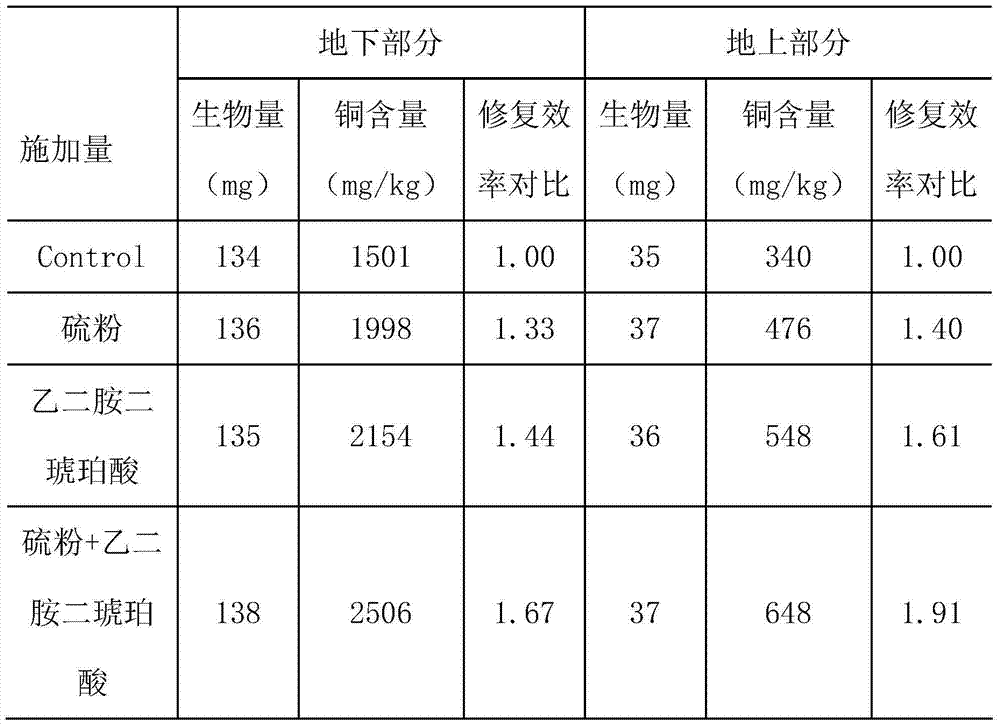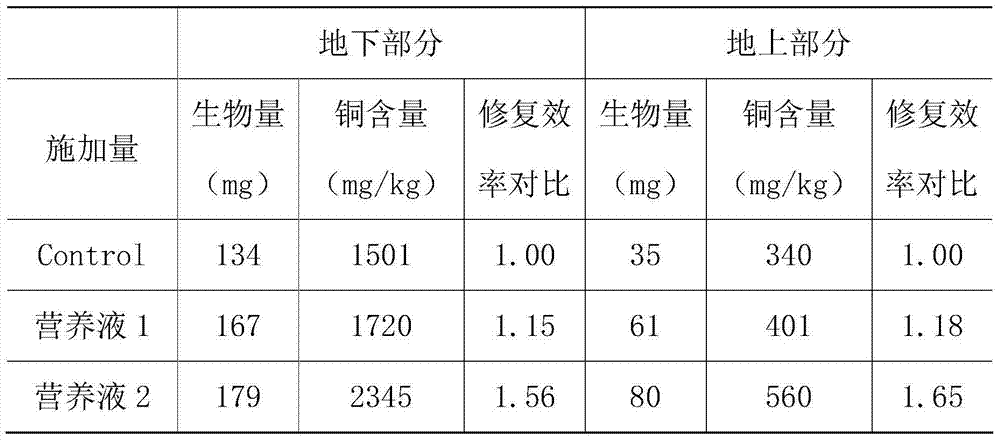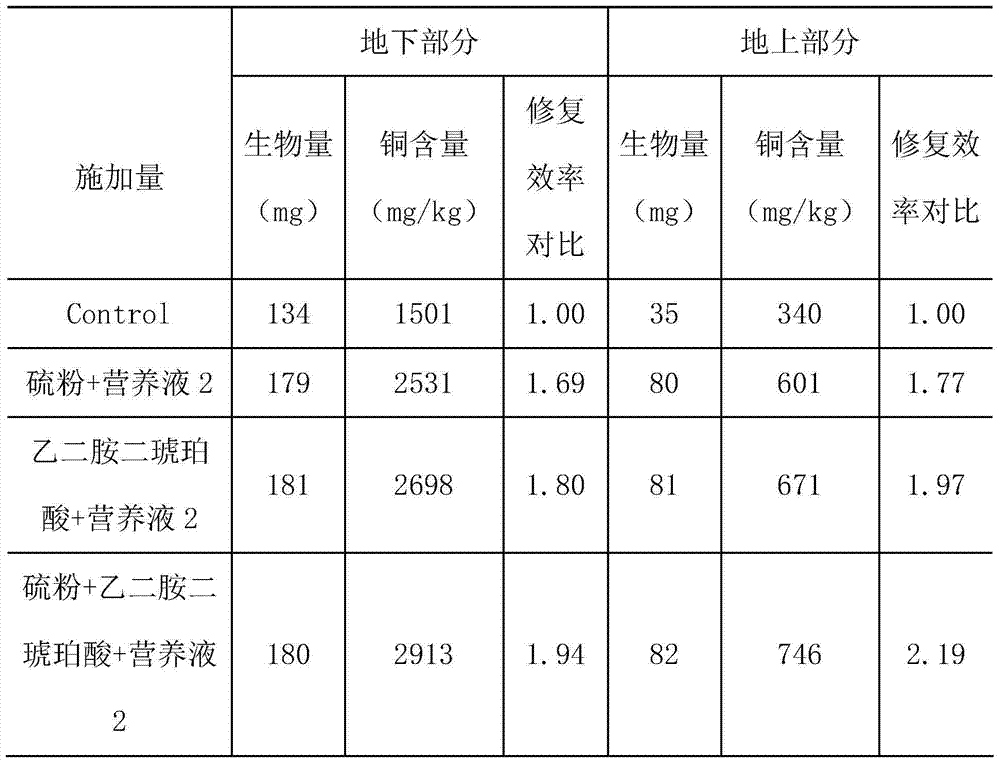Method for improving phytoremediation efficiency of copper-polluted soil
A phytoremediation and copper pollution technology, applied in the field of phytoremediation of heavy metal contaminated soil, can solve the problems of dwarf plants, small biomass, slow growth, etc., and achieve the effects of fast absorption, accelerated growth, and alleviation of biological toxicity.
- Summary
- Abstract
- Description
- Claims
- Application Information
AI Technical Summary
Problems solved by technology
Method used
Image
Examples
Embodiment 1
[0038] The selected species of Haizhou Lemongrass is Haizhou Lemongrass which has a history of more than 3,000 years at the ancient copper mine site in Daye, Hubei. The soil used for the test is the soil of a certain mining area in Hubei. Weighing 1.5 kg, chemicals were applied to the soil according to the following scheme.
[0039] Chemical enhancers:
[0040] ① Blank control (control);
[0041] ②Sulfur powder: Add 3.87g (80mmol / kg) of industrial sulfur powder to the soil, and stir evenly as the test soil;
[0042] ③Ethylenediamine disuccinic acid: Add 1.34g (3mmol / kg) of industrial ethylenediamine disuccinic acid to the soil, and stir it evenly as the test soil;
[0043] ④Sulfur powder + ethylenediamine disuccinic acid: Add 3.87g (80mmol / kg) of industrial sulfur powder and 1.34g (3mmol / kg) of industrial ethylenediamine disuccinic acid to the soil, and stir well as the test soil .
[0044] After raising the seedlings of A. haizhouensis, the seedlings with the same growth ...
Embodiment 2
[0050] The selected species of Haizhou Lemongrass is Haizhou Lemongrass which has a history of more than 3,000 years at the ancient copper mine site in Daye, Hubei. The soil used for the test is the soil of a certain mining area in Hubei. Weighs 1.5kg.
[0051] After raising the seedlings of A. haizhouensis, the seedlings with the same growth were selected and transplanted into the test soil, one plant per pot. Move the potted plants to the greenhouse, irradiate with natural light, and water the plant seedlings regularly to prevent the seedlings from drying out. According to the following scheme, 20ml of nutrient solution was applied to the leaves of A. haizhou every 3 days after planting, harvested after 30 days, and the biomass and copper content of the underground and aerial parts of the plants were measured.
[0052] Nutrient solution:
[0053] ②Blank control (control): distilled water;
[0054] ② Nutrient solution 1: 1000ml of nutrient solution contains 56mg of NH 4 N...
Embodiment 3
[0061] The selected species of Haizhou Lemongrass is Haizhou Lemongrass which has a history of more than 3,000 years at the ancient copper mine site in Daye, Hubei. The soil used for the test is the soil of a certain mining area in Hubei. Weighing 1.5 kg, chemicals were applied to the soil according to the following scheme.
[0062] Chemical enhancers:
[0063] ① Blank control (control);
[0064] ②Sulfur powder: Add 3.87g (80mmol / kg) of industrial sulfur powder to the soil, and stir evenly as the test soil;
[0065] ③Ethylenediamine disuccinic acid: Add 1.34g (3mmol / kg) of industrial ethylenediamine disuccinic acid to the soil, and stir it evenly as the test soil;
[0066] ④Sulfur powder + ethylenediamine disuccinic acid: Add 3.87g (80mmol / kg) of industrial sulfur powder and 1.34g (3mmol / kg) of industrial ethylenediamine disuccinic acid to the soil, and stir well as the test soil .
[0067] After raising the seedlings of A. haizhouensis, the seedlings with the same growth ...
PUM
 Login to View More
Login to View More Abstract
Description
Claims
Application Information
 Login to View More
Login to View More - R&D
- Intellectual Property
- Life Sciences
- Materials
- Tech Scout
- Unparalleled Data Quality
- Higher Quality Content
- 60% Fewer Hallucinations
Browse by: Latest US Patents, China's latest patents, Technical Efficacy Thesaurus, Application Domain, Technology Topic, Popular Technical Reports.
© 2025 PatSnap. All rights reserved.Legal|Privacy policy|Modern Slavery Act Transparency Statement|Sitemap|About US| Contact US: help@patsnap.com



